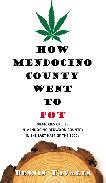"The area needs a source of money not related to drug sales with which individuals can pay their income and property taxes, on which federal, state, and county government depend."

 |
How Mendocino County Went to Pot by Dennis Tavares Trafford Publishing
book review by Priscilla Estes
The soul of a conservationist is exposed in this book that traces Mendocino County's forest, fishing and marijuana industries through the last half of the 1900s. Tavares, a retired forester for a major lumber company, lived and worked in northern California when its ocean was overfished and its forests overcut, preparing the soil for bumper crops of pot.
Through the lens of his personal value system, he examines a fifty-year span where moral relativism became popular, conservation groups became political and legislation turned sustainable conservation into unsustainable preservation. His breadth of knowledge and first-hand experiences lend credibility to this personal narrative.
His view that "locking up productive land does no good at all" is not popular today in an era when preservationists wield political clout. But as he explains the timber industry's sustained yield economy (replace what you cut, and don't cut too much); the misguided 1960 Farm Credit Act extension that encouraged overfishing; the spotted owl fiasco of the 1980s; and how marijuana grew destructive roots during the Vietnam War, you begin to see that national parks and loggers may not be natural enemies.
Tavares' fascinating insider view on how legislation and the sixties counterculture shaped the timber and fishing industries may challenge your outlook. Funny stories about the movers and shakers of the timber industry are bright threads in the narrative. The book concludes with suggestions on how to explore and use our forests and fish resources in sustainable manner. A glossary, appendix and sources provide welcome explanations.